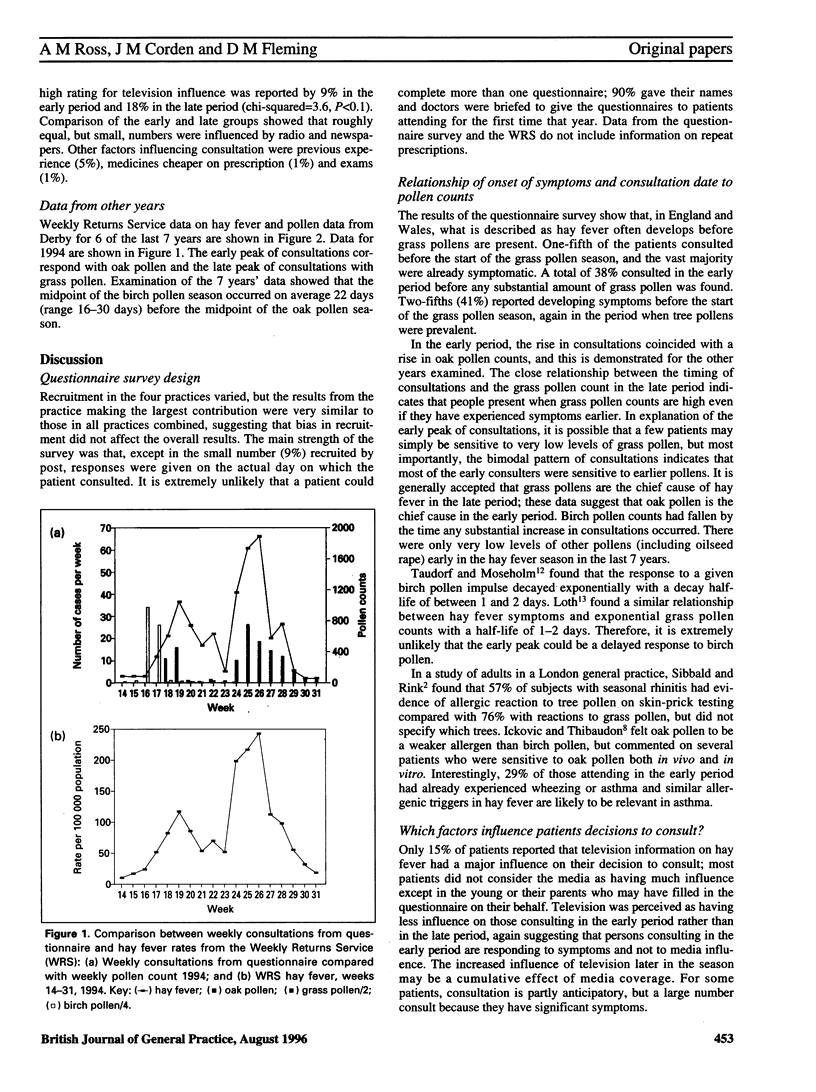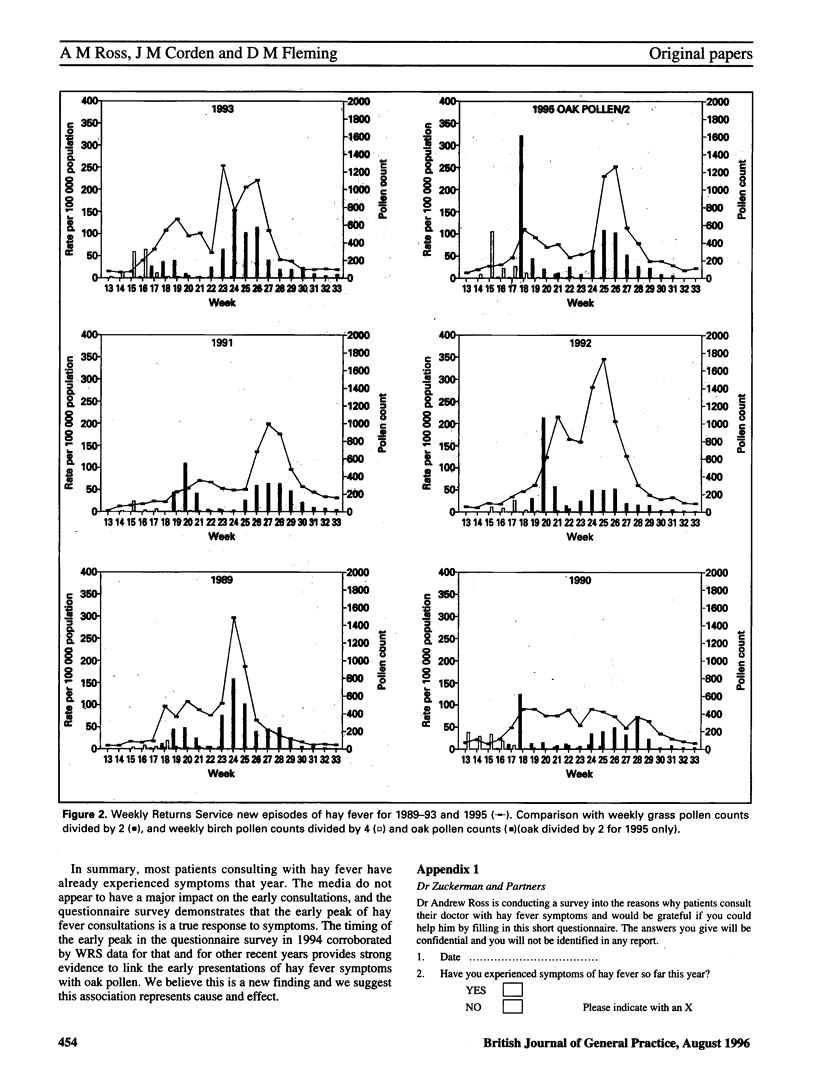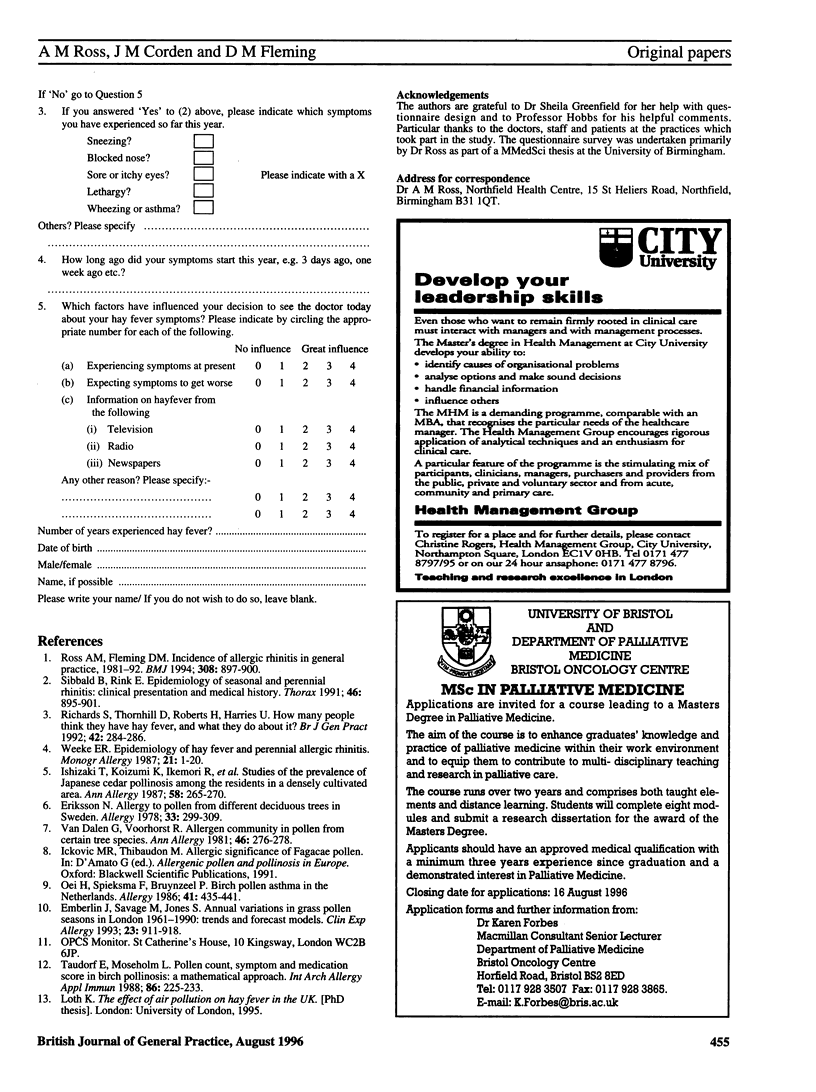Abstract
BACKGROUND: Patients often consult for hay fever before significant counts of grass pollen are recorded, and this has prompted the question, 'Are symptoms already present or are patients consulting to obtain medication in anticipation?' AIM: The study is concerned with the relationship between hay fever symptoms and pollens, and also with the impact of the media on patient consulting behaviour. METHOD: Symptom questionnaires were presented to patients consulting with hay fever for the first time that year in 1994 in four Birmingham practices. The questionnaire concerned the nature and duration of symptoms and the influence of the media on their decision to consult. Incidence data collected over the spring and summer periods (1989-1995) in the Weekly Returns Service (WRS) were examined in relation to pollen counts reported by the Midlands Asthma and Allergy Research Association at Derby. Data are presented for oak, birch and grass pollen, but other pollen data including rape, nettle and other trees were also examined. RESULTS: Questionnaire data from 1994 were analysed in two periods starting from 4 April: early (day 1-60) and late (day 61-124). Out of the 364 subjects, 38% consulted in the early period and 62% in the late period. Altogether, 41% developed symptoms before the start of the grass pollen season. Overall, 91% of patients first consulting in the early period had already experienced symptoms compared with 99% late period and were not simply collecting prescriptions in anticipation. The influence of the media on consultation behaviour was very small, except in children, 23% of whom (or their parents) were reported to be influenced. The new episode data from the WRS examined over 7 years showed an early peak that was coterminous with oak pollen, and a later and higher peak with grass pollen. CONCLUSION: The consistency of the relationship between oak pollen and the early peak of hay fever over the years examined suggests that oak pollen is a major cause of hay fever symptoms.
Full text
PDF




Selected References
These references are in PubMed. This may not be the complete list of references from this article.
- Emberlin J., Savage M., Jones S. Annual variations in grass pollen seasons in London 1961-1990: trends and forecast models. Clin Exp Allergy. 1993 Nov;23(11):911–918. doi: 10.1111/j.1365-2222.1993.tb00275.x. [DOI] [PubMed] [Google Scholar]
- Eriksson N. E. Allergy to pollen from different deciduous trees in Sweden. An investigation with skin tests, provocation tests and the radioallergosorbent test (RAST) in springtime hay fever patients. Allergy. 1978 Dec;33(6):299–309. doi: 10.1111/j.1398-9995.1978.tb01555.x. [DOI] [PubMed] [Google Scholar]
- Ishizaki T., Koizumi K., Ikemori R., Ishiyama Y., Kushibiki E. Studies of prevalence of Japanese cedar pollinosis among the residents in a densely cultivated area. Ann Allergy. 1987 Apr;58(4):265–270. [PubMed] [Google Scholar]
- Oei H. D., Spieksma F. T., Bruynzeel P. L. Birch pollen asthma in The Netherlands. Allergy. 1986 Aug;41(6):435–441. doi: 10.1111/j.1398-9995.1986.tb00324.x. [DOI] [PubMed] [Google Scholar]
- Richards S., Thornhill D., Roberts H., Harries U. How many people think they have hay fever, and what they do about it. Br J Gen Pract. 1992 Jul;42(360):284–286. [PMC free article] [PubMed] [Google Scholar]
- Ross A. M., Fleming D. M. Incidence of allergic rhinitis in general practice, 1981-92. BMJ. 1994 Apr 2;308(6933):897–900. doi: 10.1136/bmj.308.6933.897. [DOI] [PMC free article] [PubMed] [Google Scholar]
- Sibbald B., Rink E. Epidemiology of seasonal and perennial rhinitis: clinical presentation and medical history. Thorax. 1991 Dec;46(12):895–901. doi: 10.1136/thx.46.12.895. [DOI] [PMC free article] [PubMed] [Google Scholar]
- Taudorf E., Moseholm L. Pollen count, symptom and medicine score in birch pollinosis. A mathematical approach. Int Arch Allergy Appl Immunol. 1988;86(2):225–233. doi: 10.1159/000234576. [DOI] [PubMed] [Google Scholar]
- Weeke E. R. Epidemiology of hay fever and perennial allergic rhinitis. Monogr Allergy. 1987;21:1–20. [PubMed] [Google Scholar]
- van Dalen G., Voorhorst R. Allergen community in pollen from certain tree species. Ann Allergy. 1981 May;46(5):276–278. [PubMed] [Google Scholar]


